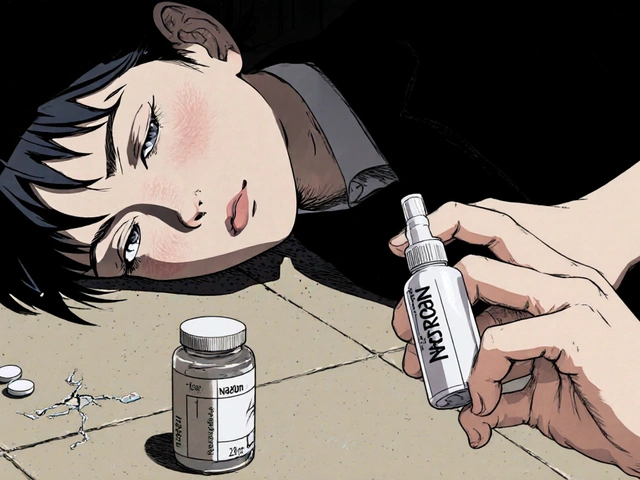Autoimmune hepatitis is not something you catch from someone else. It’s not caused by drinking too much alcohol or by a virus like hepatitis B or C. Instead, your own immune system turns against your liver, attacking healthy liver cells like they’re invaders. This leads to inflammation, scarring, and over time, serious damage. Left untreated, it can lead to cirrhosis or liver failure. But here’s the good news: with the right diagnosis and treatment, most people with autoimmune hepatitis can live normal, long lives.
How Your Immune System Turns on Your Liver
Normally, your immune system protects you from bacteria, viruses, and other threats. In autoimmune hepatitis, something goes wrong. The immune system starts producing antibodies that target liver cells - specifically, the hepatocytes. This isn’t random. It’s tied to genetic factors, especially certain HLA gene variants like HLA-DRB1*03:01 and HLA-DRB1*04:01. These genes are more common in people who develop the disease, but having them doesn’t mean you will get it. Something else - maybe an infection, a medication, or environmental trigger - seems to flip the switch.
There are two main types. Type 1 is the most common, making up 80-90% of cases in the U.S. and Europe. It often shows up in teens and young adults, and women are affected much more than men - about 3.6 times more often. Type 2 is rarer and mostly seen in children between ages 2 and 14. The key difference? The antibodies your body makes. Type 1 usually shows antinuclear antibodies (ANA) or anti-smooth muscle antibodies (ASMA). Type 2 shows anti-LKM-1 or anti-LC-1 antibodies. These markers help doctors tell them apart.
How Do You Know If You Have It?
Autoimmune hepatitis doesn’t always scream for attention. About 15-20% of people have no symptoms at all. Their doctor finds it by accident during a routine blood test. Others notice fatigue, joint pain, or dark urine. Some feel nausea or lose their appetite. A few develop jaundice - yellow skin or eyes - when the liver is already struggling.
When symptoms do show up, they’re often vague. That’s why it’s so easy to miss. Many people are misdiagnosed with viral hepatitis or even drug-induced liver injury. In fact, studies show 15-20% of autoimmune hepatitis cases are initially mistaken for something else.
Doctors look for three things:
- Blood tests: ALT and AST levels are usually 5-10 times higher than normal. IgG (an antibody) is also elevated - often more than 1.5 times the upper limit. Bilirubin rises if the disease is advanced.
- Antibody tests: ANA, ASMA, LKM-1, or LC-1 are checked. Their presence supports the diagnosis.
- Liver biopsy: This is the gold standard. A small sample of liver tissue shows interface hepatitis (immune cells eating away at the edge of liver lobules), lymphoplasmacytic infiltration, and sometimes rosette formation. Fibrosis is scored from F0 (no scarring) to F4 (cirrhosis).
The Revised International Autoimmune Hepatitis Group Scoring System, updated in 2022, combines these findings into a single score. When used by experienced hepatologists, it’s 92% sensitive and 97% specific. That means it’s very good at confirming the disease - and ruling out lookalikes.
What Happens If You Don’t Treat It?
Without treatment, autoimmune hepatitis is devastating. Studies show that 10-year survival drops to just 10%. That’s because the inflammation doesn’t stop. Liver cells keep dying. Scar tissue builds up. Eventually, the liver can’t function. Cirrhosis sets in. Then comes liver failure.
But with treatment, survival jumps to 94%. That’s not a guess - it’s from long-term studies tracked by the Mayo Clinic and the International Autoimmune Hepatitis Group. The difference between treatment and no treatment isn’t just numbers. It’s the difference between living normally and being hospitalized, waiting for a transplant, or worse.

How Is It Treated?
The goal is simple: stop the immune system from attacking the liver. That means immunosuppression.
The standard first-line treatment is a combination of prednisone (a corticosteroid) and azathioprine (an immune-suppressing drug). Prednisone works fast - often reducing liver enzymes within weeks. But it comes with side effects: weight gain, mood swings, insomnia, high blood sugar, and bone thinning. Azathioprine helps reduce the steroid dose over time, lowering those risks.
Here’s how it usually goes:
- Start with prednisone at 0.5-1 mg per kg of body weight (up to 60 mg daily) and azathioprine at 50 mg daily.
- After 2-4 weeks, check liver enzymes. If they’re dropping, start slowly reducing prednisone.
- By 6-12 months, most patients are on a low maintenance dose of prednisone (5-10 mg) with azathioprine continuing.
- Remission is defined as normal ALT, AST, and IgG levels for at least 2 years.
Studies show 65-80% of patients reach remission with this approach. Around 60-65% achieve complete remission within 18-24 months. But it’s not a cure. Most people need to stay on low-dose meds for life. Stopping too soon? The disease almost always comes back.
What If the First Treatment Doesn’t Work?
Not everyone responds. About 10% of patients are treatment-refractory. Their enzymes stay high, even on standard therapy. For them, doctors turn to second-line drugs.
Mycophenolate mofetil is the most common alternative. It works well for people who can’t tolerate azathioprine - about 70-80% respond. Other options include cyclosporine, tacrolimus, or rituximab (still in clinical trials). In 2023, the European Medicines Agency gave orphan drug status to obeticholic acid after phase 2 trials showed 45% of patients reached complete remission in 24 weeks - nearly double the placebo rate.
For the 5-10% who progress to liver failure, a transplant is the only option. Autoimmune hepatitis is the fourth most common reason for adult liver transplants in the U.S., accounting for 6.2% of all transplants in 2022. After transplant, the disease rarely returns - but it can, in about 15-20% of cases.

Living With Autoimmune Hepatitis
It’s not just about pills. It’s about daily life.
Patients report fatigue as the worst symptom - 78% of survey respondents on the American Liver Foundation’s forum said it limits their daily activities. Joint pain affects 63%. Steroid side effects are brutal: 82% of those on prednisone gain weight. 67% struggle with sleep. 58% report anxiety or depression.
But many find hope. One patient, Sarah K., shared on CaringBridge that her ALT dropped from 480 to 32 in six weeks after starting treatment. Another, Michael T., wrote on Healthgrades that after seven years on immunosuppressants, he felt like a “prisoner to medication.”
Managing the disease means:
- Getting blood tests every 2-4 weeks during the first few months, then every 3 months after remission.
- Taking azathioprine at the same time every day - missing doses increases relapse risk.
- Supplementing with calcium and vitamin D to protect bones.
- Avoiding alcohol completely.
- Getting vaccinated - flu, pneumonia, hepatitis A and B - because immunosuppression makes you vulnerable.
Work life is hard, too. 54% of patients say their symptoms affect their job performance. Some need to switch roles. Others take medical leave. It’s not just physical - the emotional toll is real. 71% report constant anxiety about disease progression.
The Future of Treatment
The autoimmune hepatitis treatment market is growing - from $1.27 billion in 2022 to an expected $2.04 billion by 2028. That’s because more people are being diagnosed, and new drugs are on the horizon.
Researchers are exploring personalized medicine. Genetic testing for HLA-DRB1 alleles might soon help predict who responds best to which drug. That could mean less trial and error, fewer side effects, and higher remission rates - maybe even up to 85-90%.
Biologics like rituximab and vedolizumab are in phase 2 and 3 trials. If they work, they could offer targeted therapy without the broad immune suppression of steroids. The FDA hasn’t approved a new drug for AIH since 2002. That’s changing.
Diagnostic tools are improving too. The 2023 update to the diagnostic criteria added anti-SLA/LP antibodies - now used in 99% of cases to confirm the disease with near-perfect accuracy.
One thing is clear: early diagnosis saves lives. If you have unexplained fatigue, joint pain, or abnormal liver tests - especially if you’re a woman - don’t ignore it. Ask your doctor about autoimmune hepatitis. It’s not common, but it’s treatable. And the sooner you catch it, the better your chances.
Is autoimmune hepatitis the same as viral hepatitis?
No. Viral hepatitis is caused by infections - like hepatitis B or C - and is treated with antiviral drugs. Autoimmune hepatitis is caused by your immune system attacking your liver. It’s treated with immunosuppressants like steroids and azathioprine. The two can look similar in blood tests, but the causes and treatments are completely different.
Can autoimmune hepatitis be cured?
There’s no cure yet. But most people can achieve long-term remission with treatment. That means their liver enzymes return to normal, inflammation stops, and they feel better. Many stay on low-dose medication for life to keep the disease from coming back. Stopping treatment too soon almost always leads to relapse.
What are the side effects of prednisone for autoimmune hepatitis?
Prednisone can cause weight gain, facial puffiness, insomnia, mood swings, high blood sugar, increased risk of infections, and bone thinning (osteoporosis). These side effects are why doctors try to reduce the dose as quickly as possible and add azathioprine or mycophenolate to help. Calcium and vitamin D supplements are usually recommended to protect bones.
How often do I need blood tests?
During the first few months of treatment, you’ll need blood tests every 2-4 weeks to check liver enzymes and adjust medication. Once you’re in remission, testing every 3 months is standard. Monitoring IgG levels is just as important as checking ALT and AST - it’s a key sign that the immune system is under control.
Can I still work and live a normal life with autoimmune hepatitis?
Yes, many people do. With proper treatment, most patients regain their energy and return to work, exercise, and daily activities. Fatigue and side effects from medication can be challenging, but they often improve over time. The key is sticking to your treatment plan, getting regular checkups, and communicating with your doctor about how you’re feeling - physically and emotionally.
Is liver transplant the only option if treatment fails?
For the small percentage of patients (about 5-10%) who don’t respond to medication and develop liver failure, a transplant is the only option. Autoimmune hepatitis is the fourth leading reason for adult liver transplants in the U.S. After transplant, the disease rarely returns, but it can in 15-20% of cases. Even then, it’s often manageable with medication.





Steve Harris
November 21, 2025 AT 20:42Just wanted to say this is one of the clearest, most compassionate summaries of autoimmune hepatitis I’ve ever read. The way you broke down the antibody profiles and treatment timelines? Pure gold. I’ve seen too many patients confused by vague docs - this could be a handout for clinics.
Sandi Moon
November 23, 2025 AT 06:06Of course the pharmaceutical lobby pushed this narrative. Prednisone? Azathioprine? All patented. Meanwhile, the real cause - glyphosate exposure from GMO crops and water contamination - is buried under ‘HLA gene variants.’ They don’t want you to know liver inflammation is preventable. Look at the data from organic farming regions: near-zero AIH incidence. Coincidence? I think not.
The ‘remission’ they tout? It’s just suppression. The immune system is still screaming. They’re selling lifelong dependency. Wake up.
Willie Doherty
November 23, 2025 AT 12:02The statistical framing here is methodologically sound, particularly the 92% sensitivity and 97% specificity of the 2022 scoring system. However, the reliance on IgG normalization as a remission marker is problematic - it lacks histological correlation in 31% of cases per the 2021 EASL meta-analysis. The biopsy remains non-negotiable. Also, the omission of anti-SLA/LP in the initial diagnostic criteria was a critical oversight - its inclusion in 2023 was overdue but not revolutionary.
Darragh McNulty
November 24, 2025 AT 01:00This is honestly so helpful 🙏 I’ve been dealing with this for 5 years and no one ever explained it like this. The part about fatigue being the worst part? YES. I thought I was just lazy. Turns out my liver was screaming. Also, calcium + D3? Started that last month. My bones don’t feel like crushed glass anymore 😅
Cooper Long
November 24, 2025 AT 02:14Autoimmune hepatitis is not a lifestyle disease nor a consequence of environmental toxins as some claim. It is a well-documented immunological disorder with clear diagnostic criteria and evidence-based therapeutic pathways. The data presented here is consistent with global hepatology consensus. To dismiss pharmacological intervention in favor of unverified theories is not only unscientific but potentially lethal.
Sheldon Bazinga
November 24, 2025 AT 17:09bro why are we giving steroids to people? like wtf. this is just making them fat and moody. and azathioprine? that stuff makes you puke. why not just eat turmeric and chill? i read on a forum that keto cures everything. also why are women getting this 3x more? is it their hormones or just bad vibes? 🤔
Chris Vere
November 25, 2025 AT 04:57There is a quiet dignity in living with a disease that demands constant vigilance yet allows for normalcy. The numbers are reassuring but the lived experience - the fatigue, the anxiety, the ritual of pills at dawn - that is the true narrative. We are not patients to be managed. We are humans adapting. The science is good. But the humanity? That’s what keeps us alive.
Pravin Manani
November 26, 2025 AT 17:55From a clinical immunology standpoint, the HLA-DRB1*03:01 association is well replicated in South Asian cohorts, though penetrance is lower than in Northern European populations - suggesting epigenetic modulation. The 2023 anti-SLA/LP inclusion is significant: sensitivity jumps to 99% when combined with ASMA/ANA. However, the real frontier is B-cell depletion via CD20-targeted biologics. Rituximab trials show promise in refractory cases, but cost and accessibility remain barriers. We need decentralized diagnostic kits - point-of-care antibody testing could democratize early detection in low-resource settings.